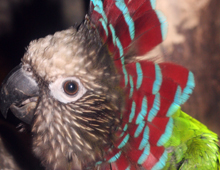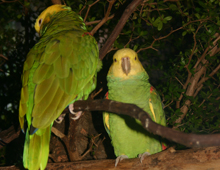
This marvelous parrot was one of the first New World animals brought alive to Europe, in the 1500s. Long before, it was prized as a pet, and for its feathers, by many Native American cultures. Live birds were traded to Arizona and New Mexico from Mexico for more than 700 years. Known as Mo to the Mayans, it was revered by their Kings, some of who wore rubber rings on their faces in honor of it. Threatened in Mexico and Central America, it remains common in much of South America. First hatched in the US in 1916, it breeds well in captivity.






